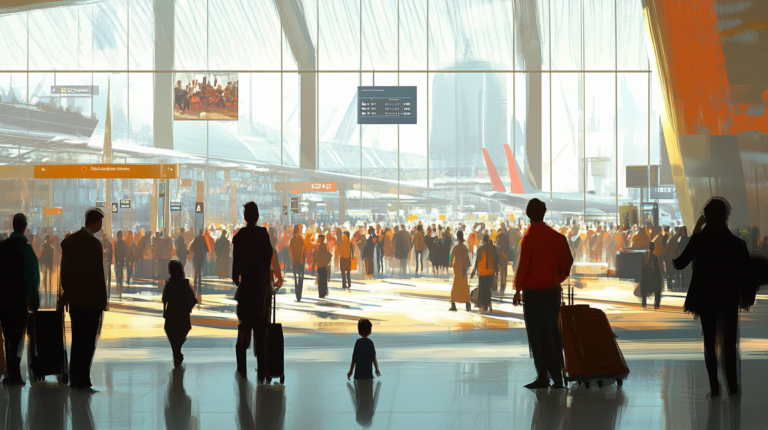Eight Must-Know Types of Business Travel for Frequent Flyers

1. Corporate Meetings

In my own experience, corporate meetings are the lifeblood of organizational alignment. These short, focused events allow teams or executive leaders to gather over a few days and clarify pressing objectives. While virtual voice and video calls offer convenience, there’s something about the energy in a physical boardroom that fosters honest discussions and more nuanced negotiations. According to a recent analysis by the Harvard Business Review, in-person meetings can generate higher levels of trust and productivity compared to digital-only interactions.
I’ve noticed that many companies in 2025 continue to adopt comprehensive travel management platforms to streamline booking, expense tracking, and policy enforcement for these quick get-togethers. By integrating travel data into a single system, businesses can track who’s flying where, reduce booking errors, and keep a handle on budgets. With these systems, it’s easier than ever to confidently schedule on-site syncs or team summits without the fear of logistical nightmares.
A key advantage of corporate meetings lies in face-to-face brainstorming sessions. Whiteboard sketches come to life when everyone is physically present and free from digital distractions. It might sound old school, but I’ve found that the ability to walk over and chat with the person next to you can ignite fresh ideas when you least expect them.
2. Conferences & Seminars

Conferences and seminars bring together professionals hungry for insights, networking, and new collaborations. In my travels, I’ve observed that these gatherings often deliver more long-term value than a simple business trip because you’re not just meeting a single client; you’re immersing yourself in a specialized community. Attendees can learn from experts on industry trends, market forecasts, and emerging technologies. For instance, according to data presented at several top technology symposiums, in-person conference sessions tend to yield a 30% higher retention rate in attendees compared to online webinars.
Another benefit is the unique synergy that emerges from hallway chats or coffee breaks between sessions. I’ve seen startups form partnerships with established corporations simply because they ended up seated next to each other during a keynote. The spontaneity of in-person networking is nearly impossible to replicate in a purely virtual setting. Hearing lived experiences from peers—whether it’s a marketing guru who pioneered a new campaign or a tech engineer who discovered an innovative fix—can be a game-changer for your own projects.
To maximize productivity at conferences, many travelers rely on specialized scheduling apps. These tools let you bookmark sessions, set up one-on-one meetings, and receive reminders so you don’t miss any crucial insights. While virtual summits have certainly carved out a niche, the tactile experience at traditional conferences continues to offer priceless learning and real bonding opportunities.
3. Trade Shows

Trade shows have always been close to my heart because they blend product launches, competitive research, and customer engagement into one lively setting. Whether you’re unveiling the latest software or scoping out rival offerings, walking through the exhibition floor can give you a bigger perspective on the market landscape. According to industry data, up to 81% of trade show attendees have buying authority, which underscores the potential to drum up direct revenue through booth interactions.
Logistically, trade shows demand careful planning. I’ve spent countless hours figuring out booth layouts, shipping materials, and securing accessible accommodations to keep teams productive. Booking a stay with easy access to the venue might sound like a small detail, but it can significantly reduce early morning stress. Transportation partners and shuttle services also play a critical role, especially with multi-day shows where attendees frequently shuffle between event halls and networking dinners.
For teams traveling internationally, it’s valuable to factor in time zone adjustments and local customs. Jet lag can be a real hurdle, so arriving a day or two earlier can help you acclimate. Plus, demonstrations go more smoothly when everyone’s operating on a good night’s sleep. When you’re ready to leave, encourage your team to pack an extra bag—there’s always a stash of brochures, samples, or new gear to bring home.
4. Team Building Retreats

Over the years, I’ve seen team-building retreats evolve from generic trust exercises to holistic experiences that build long-lasting camaraderie. These off-site events often blend fun activities—like ropes courses, escape rooms, or cooking classes—with deeper, reflective sessions about strategic goals. For example, a 2023 study in the Journal of Organizational Behavior linked company retreats to a 25% rise in team performance metrics, largely due to improved interpersonal communication.
The magic of spending a weekend away from daily office pressures is that colleagues get to see each other as individuals, not just job titles. I remember one retreat where a notoriously reserved software developer stunned everyone by leading a drumming circle, immediately transforming team dynamics. These shared memories form a well of positivity the team can draw on when challenges arise in the future.
If you’re planning a retreat, focus on quality over quantity. Opt for a few meaningful activities rather than overloading the schedule. It’s also helpful to solicit feedback on the venue, dietary options, and even room assignments if employees are sharing lodgings. A sense of inclusion and respect for personal preferences goes a long way toward making everyone feel welcome, fostering deeper trust and collaboration.
5. Bleisure Travel

Bleisure travel—combining business obligations and leisure time—has skyrocketed in popularity. I’ve watched many travelers tack on a few days of sightseeing or relaxation after packed work schedules. It’s a chance to recharge and explore a new city beyond the confines of conference halls. Research by the Global Business Travel Association indicates that nearly 60% of business trips in 2025 now include at least one leisure component.
One of the things I really love about bleisure travel is how it helps mitigate burnout. When you’re able to step away from spreadsheets or presentations and soak in the local culture, you return home with renewed enthusiasm. All it takes is a single evening strolling around a historic district or sampling local cuisine to remind you that there’s more to life than the next deadline. It’s also a great way to build cultural awareness—visiting museums, galleries, or even local festivals can offer insights that might spark an idea in your next project.
That said, striking a balance is key. Make sure your employer’s travel policy supports bleisure add-ons, and communicate clearly about cost responsibilities. You might cover the extra hotel nights and activities personally, while your company handles the core business travel expenses. With that transparency in place, bleisure travel can be a win-win for both personal growth and professional obligations.
6. Site Visits & Offshore Work

I’ve found that site visits and offshore assignments provide some of the most eye-opening moments in a career. If you’re overseeing a production unit in another country or supporting a global client, actually seeing the day-to-day operations can offer insights no video call can match. It’s much easier to diagnose process inefficiencies or morale issues when you’re there in person, talking to employees and observing workflow dynamics.
When planning these trips, always factor in additional complexities like visas, local lodging, and even language barriers. I once spent two weeks at a remote engineering facility in Southeast Asia. By being on the ground, I discovered small but impactful workflow errors, which we fixed on the spot, saving thousands of dollars in the long run. Live discussions with local teams also helped me build trust; they appreciated that leadership cared enough to spend time understanding their challenges.
According to a 2024 McKinsey report, nearly 70% of organizations with global footprints see on-site visits as critical to operational success. Indeed, bridging time zones via in-person interactions fosters deeper connections and can expedite decision-making, especially when stakeholders are spread across continents.
7. Incentive Trips

Incentive trips aim to reward and motivate high performers, and personally, I’ve watched these experiences spark loyalty and perseverance among teams. These can be anything from a weekend island getaway to a multi-day adventure in the mountains. Beyond relaxation, these trips are powerful culture builders. Employees return feeling valued, often sharing stories that inspire the rest of the organization to aim higher.
While these excursions can be lavish, they’re not purely about fun and games. They can double as informal team-building exercises—even a beachfront BBQ can encourage cross-departmental mingling. A recent study by the Incentive Research Foundation found that 75% of participants on incentive trips reported increased job satisfaction and a stronger bond with coworkers. I’ve certainly seen how acknowledging achievements with epic rewards can elevate morale and spark fresh ideas for upcoming projects.
For companies, the ROI can be significant if carefully executed. Besides boosting employee retention, top-notch incentive trips can lead to stronger brand advocacy: participants often share positive experiences on social media, presenting the organization in a favorable light. Planning is key—clear communication on qualification criteria, travel logistics, and event timing fosters excitement rather than confusion.
8. Hiring & Training Events

Companies frequently host recruitment fairs, college-campus events, or specialized training sessions abroad, and I’ve observed how these face-to-face interactions offer an unmatched opportunity to showcase your corporate culture. During a workshop I attended, recruiters not only interviewed candidates but also conducted mini-seminars on emerging industry trends. The immediate Q&A sessions built rapport and trust, which can be hard to replicate with digital resumes and video calls.
Onboarding new hires or upskilling current employees in person can expedite learning, especially for nuanced roles. Hands-on exercises allow attendees to grasp complex concepts rapidly, and training facilitators can adapt on the fly based on participants’ questions. A 2023 LinkedIn Learning report supports this idea, noting that in-person training retains higher engagement rates and fosters a sense of accountability among attendees.
However, the logistical details shouldn’t be underestimated. Whether you’re booking flights for top prospects or organizing hotel rooms for trainers, having a travel policy and budget that accommodates diverse needs is essential. When it’s done right, these events not only acquire new talent but also elevate the company’s brand within professional circles.
The Tech Advantage

Technology’s rapid advancement continues to transform business travel. I’ve relied on platforms like Itilite and Ayruu for everything from automated flight comparisons to real-time itinerary updates—critical features if you’re racing the clock and adjusting plans mid-trip. These tools centralize expense management, making reimbursements or cost reconciliation much simpler.
Beyond booking flights and hotels, AI-driven apps also offer data-driven insights into traveler preferences and corporate spending patterns. According to the Global Business Travel Association, companies that leverage modern travel management solutions report a 20% reduction in travel glitches, such as flight cancellations or compliance issues. This efficiency not only saves time but also fosters happier employees who don’t have to sweat the small stuff.
Sustainability has also emerged as a driving factor in tech adoption. Many startups and established players now include eco-friendly flight suggestions, carbon offset options, or advanced filters for green-certified lodging. With these features, organizations can align travel with their corporate social responsibility goals while ensuring traveler comfort.
Conclusion: The Future of Corporate Travel

Even in 2025, face-to-face interaction remains an essential cornerstone for building trust, pushing innovation, and securing new business. It’s one thing to exchange messages with a potential client remotely, but it’s another to shake their hand, share a meal, and genuinely understand their concerns. These personal connections can accelerate any deal and deepen relationships faster than countless emails ever could.
At the same time, virtual technologies have advanced, providing a high-quality supplement—but not a replacement—for in-person interactions. Hybrid solutions allow us to stay connected with remote teams and global partners. However, if the goal is to truly immerse yourself in a new market or spark a lasting collaboration, traditional travel stands firm as a game-changer. The future likely lies in a balanced approach, where continuous advancements in travel tech facilitate smoother journeys while preserving the invaluable human touch.
Final Thoughts

Business travel may have adapted to new realities, but the core value of in-person connection endures. Whether it’s attending a leadership summit, exploring a trade show floor, or offering hands-on training to teams across the globe, these face-to-face experiences pay dividends in creative spark and relationship-building.
When planned responsibly, with the aid of cutting-edge travel platforms and an eye toward sustainability, business trips can be both a strategic asset and a deeply rewarding personal experience. By weaving in moments of leisure, focusing on overall well-being, and respecting different cultural contexts, you can unlock opportunities that propel both your organization and your career.
Amelia Yeaher’s Take
From my vantage point, business travel showcases humanity’s eternal desire to connect in tangible, meaningful ways. There’s something special about gathering in the same room, fueled by that shared spark of curiosity and discovery. Technology definitely helps fill in the gaps, but I still believe that a simple handshake or coffee conversation can sometimes speak louder than any digital exchange.
Over time, I’ve realized that striking a balance between efficiency and enrichment is crucial. The real magic happens when you step off the plane genuinely excited for both the goals you’ll achieve and the people you’ll meet along the way.






